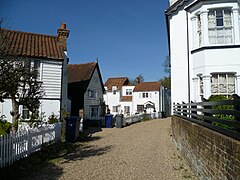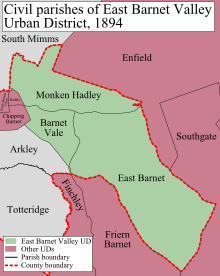Monken Hadley
| Monken Hadley | |
|---|---|
 Cottages in Monken Hadley | |
 Monken Hadley Location within Greater London | |
| OS grid reference | TQ245975 |
| London borough |
|
| Ceremonial county | Greater London |
| Region |
|
| Country | England |
| Sovereign state | United Kingdom |
| Post town | BARNET |
| Postcode district | EN5 |
| Dialling code | 020 |
| Police | Metropolitan |
| Fire | London |
| Ambulance | London |
| EU Parliament | London |
| UK Parliament |
|
| London Assembly |
|

St Mary, Monken Hadley

Little Pipers, Hadley Green Road
Monken Hadley is a place in the London Borough of Barnet. An ancient country village north of Barnet, it is now a suburban development on the very edge of Greater London 11 miles (18 km) north north-west of Charing Cross, while retaining much of its rural character.
Contents
1 History
2 Parish church
3 Sport and recreation
4 Famous residents
5 Transport links
5.1 Buses
5.2 Railway
5.3 Tube
6 Geographic location
7 See also
8 References
9 Further reading
10 External links
History

A map showing Monken Hadley parish in 1894.
The main site of the Battle of Barnet in 1471, one of the two principal engagements of the Wars of the Roses, was in the parish of Monken Hadley. Yorkist troops advanced through the village, although the action took place north (Hadley Wood) and west (Hadley Green) of the settlement. Although the retreat of the forces of Lord William Hastings (at the hands of the Earl of Oxford) took place in the parish of Barnet, all of the other key engagements were within Monken Hadley parish, including the historically significant death of Richard Neville, 16th Earl of Warwick, believed to be at the place where a monument now stands on the Great North Road.
The 4 August 1827 edition of The Mirror of Literature, Amusement, and Instruction, provides the following short history of the area:
.mw-parser-output .templatequoteoverflow:hidden;margin:1em 0;padding:0 40px.mw-parser-output .templatequote .templatequoteciteline-height:1.5em;text-align:left;padding-left:1.6em;margin-top:0
Hadley, Mankin, or Monkton, Hadley, was formerly a hamlet to Edmonton. It lies north-west of Enfield, and comprises 580 acres, including 240 allotted in lieu of the common enclosure of Enfield Chase. Its name is compounded of two Saxon words – Head-leagh, or a high place; Mankin is probably derived from the connexion of the place with the abbey of Walden, to which it was given by Geoffrey de Mandeville, earl of Essex, under the name of the Hermitage of Hadley. The village is situated on the east side of the great north road, eleven miles from London.
The manor belonged to the Mandevilles, the founder of the Hermitage, and was given by Geoffrey to the monks of Walden; in the ensuing two centuries the manorial property underwent various transmissions, and was purchased by the Pinney family, in the year 1791, by the present proprietor, Peter Moore, Esq.
The house of David Garrow, father to the present judge of that name in the court of exchequer, is supposed to have been connected with a monastic establishment. Chimney-pieces remain in alto-relievo: on one is sculptured the story of Sampson; the other represents many passages in the life of our Saviour, from his birth in the stall to his death on the cross.
The parish church is a handsome structure, built at different periods. The chancel bears marks of great antiquity, but the body has been built with bricks. At the west end is a square tower, composed of flint, with quoins of freestone; on one side is the date Anno Domini 1393, cut in stone – one side of the stone bearing date in the sculptured device of a wing; the other that of a rose. The figures denote the year 1494; the last, like the second numerical, being the half eight, often used in ancient inscriptions. The unique vestige of the Middle Ages, namely, a firepan, or pitchpot, on the south-west tower of the church, was blown down in January, 1779 and carefully repaired, though now not required for the purpose of giving an alarm at the approach of a foe, by lighting pitch within it. The church has been supposed to have been erected by Edward IV as a chapel for religious service, to the memory of those who fell in the battle of Barnet in 1471.
On the window of the north transept are some remains of painted glass, among which may be noticed the rebus of the Gooders, a family of considerable consequence at Hadley in the fifteenth and sixteenth centuries. This consists of a partridge with an ear of wheat in its bill; on an annexed scroll is the word Gooder; on the capital of one of the pillars are two partridges with ears of corn in the mouth, an evident repetition of the same punning device, and it is probable the Gooder's were considerable benefactors towards building the church.
The almshouses for six decayed housekeepers were founded by Sir Roger Willbraham in 1616, but so slenderly endowed that they do not produce more than 9l.6s. annually. Major Delafonte, in 1762, increased the annuity, which expired in 1805; but Mr. Cottrell gained by subscription 2375l. in trust. The father of Mr. Whitbread, the statesman, subscribed the sum of 1000l. for the support of the almshouses. The charity-school for girls was established in 1773, and was enlarged and converted into a school of industry in 1800. Twenty girls in the establishment receive annually the sum of 1l. towards clothing; thirty girls besides the above are admitted to the benefit of education, on paying the weekly sum of 2d. and succeed to the vacancies which occur in the class more largely assisted. This charity is in like manner supported by contributions on the inhabitants. The boys' school, supported in the same way, which in 1804 amounted to the sum of 103l. 10s., has about seventy day-scholars; twenty are allowed 1l. towards clothing, and instructed without any charge; the remainder pay 2d. weekly.
Historically Monken Hadley was a civil parish of Middlesex forming part of a small protrusion into Hertfordshire. In 1889, under the Local Government Act 1888, the civil parish was transferred to Hertfordshire. Under the Local Government Act 1894 the parish was split with a Hadley parish becoming part of the Barnet Urban District, while the remaining part of the parish became part of the East Barnet Urban District of Hertfordshire. In 1965, under the London Government Act 1963, its area was transferred to Greater London and combined with that of other districts formerly in Hertfordshire and Middlesex to form the present-day London Borough of Barnet.[1]
Parish church
The parish church of St Mary the Virgin was built in its present form in 1494 (the date being carved in stone over the west door) although a church is believed to have stood on the site for more than 800 years. The present building is in the perpendicular style, and includes two side chapels (in transepts) dedicated to St Anne and St Catherine. The building was heavily renovated in Victorian times, and contains large quantities of Victorian woodwork furniture. The parish and church were heavily influenced by tractarianism and the Oxford Movement,[2] and it remains a focus of eucharistic worship within the surrounding district.
Sport and recreation
Monken Hadley has a Non-League football team Hadley F.C. who play at Parkfield.
Monken Hadley has a King George's Fields open space in memorial to King George V. It is popular for tobogganing when there has been a good fall of snow The field descends into the Hadley Woods, which make their way into East Barnet Golf course. Hadley Green is a Local Nature Reserve which is a Site of Metropolitan Importance, and traditionally considered the main site of the Battle of Barnet.
Hadley Common has a cricket field, home to a well-known cricket club, Monken Hadley CC, which is mentioned in one of the works of Anthony Trollope, who lived in Monken Hadley.
Famous residents
- The great adversarial lawyer Sir William Garrow (1760–1840), coiner of the phrase "innocent until proven guilty", was born and brought up in the village.
Sir Roger Wilbraham (1553–1616), Solicitor-General for Ireland, lived here towards the end of his life and is buried here.[3] He founded the local Wilbraham's Almshouses.[4]
Anthony Upton, a High Court judge in Ireland, was born here in 1656.- The writers Kingsley Amis and Elizabeth Jane Howard lived for a time in Lemmons, a house near the Common, where their friend the Poet Laureate Cecil Day-Lewis died.
Transport links
Buses
Monken Hadley and Hadley Green are not well-served by bus routes, with most services terminating further south in Barnet. The two Transport for London routes which run nearby are:
84 – New Barnet railway station to St Albans
399 – Barnet (the Spires) to Hadley Wood railway station – circular service; Monday to Saturday shopping hours only.
Railway
Both fairly nearby are:
New Barnet railway station – First Capital Connect
Hadley Wood railway station – First Capital Connect
Tube
Two tube stations are relatively nearby:
High Barnet (Northern Line), some distance to the south, within walking distance, but accessible via the 84 bus, is the closer of the two.
Cockfosters (Piccadilly Line), at the other (eastern) end of Monken Hadley, accessible via a longer walk across Monken Hadley Common.
Geographic location
See also
- Battle of Barnet
- Hadley Brewery
- Hadley Green
- King George's Fields
- List of listed buildings in Hadley
- Monken Hadley Common
References
^ Vision of Britain – Monken Hadley parish Archived 11 March 2007 at the Wayback Machine (historic map[dead link])
^ See the British History Online website.
^ "Wilbraham, Sir Roger (1553–1616), of St. John's Gateway, Clerkenwell, London; later of Ludgraves, Monken Hadley, Mdx", The History of Parliament: the House of Commons 1604–1629, History of Parliament Trust, retrieved 13 January 2013.mw-parser-output cite.citationfont-style:inherit.mw-parser-output .citation qquotes:"""""""'""'".mw-parser-output .citation .cs1-lock-free abackground:url("//upload.wikimedia.org/wikipedia/commons/thumb/6/65/Lock-green.svg/9px-Lock-green.svg.png")no-repeat;background-position:right .1em center.mw-parser-output .citation .cs1-lock-limited a,.mw-parser-output .citation .cs1-lock-registration abackground:url("//upload.wikimedia.org/wikipedia/commons/thumb/d/d6/Lock-gray-alt-2.svg/9px-Lock-gray-alt-2.svg.png")no-repeat;background-position:right .1em center.mw-parser-output .citation .cs1-lock-subscription abackground:url("//upload.wikimedia.org/wikipedia/commons/thumb/a/aa/Lock-red-alt-2.svg/9px-Lock-red-alt-2.svg.png")no-repeat;background-position:right .1em center.mw-parser-output .cs1-subscription,.mw-parser-output .cs1-registrationcolor:#555.mw-parser-output .cs1-subscription span,.mw-parser-output .cs1-registration spanborder-bottom:1px dotted;cursor:help.mw-parser-output .cs1-ws-icon abackground:url("//upload.wikimedia.org/wikipedia/commons/thumb/4/4c/Wikisource-logo.svg/12px-Wikisource-logo.svg.png")no-repeat;background-position:right .1em center.mw-parser-output code.cs1-codecolor:inherit;background:inherit;border:inherit;padding:inherit.mw-parser-output .cs1-hidden-errordisplay:none;font-size:100%.mw-parser-output .cs1-visible-errorfont-size:100%.mw-parser-output .cs1-maintdisplay:none;color:#33aa33;margin-left:0.3em.mw-parser-output .cs1-subscription,.mw-parser-output .cs1-registration,.mw-parser-output .cs1-formatfont-size:95%.mw-parser-output .cs1-kern-left,.mw-parser-output .cs1-kern-wl-leftpadding-left:0.2em.mw-parser-output .cs1-kern-right,.mw-parser-output .cs1-kern-wl-rightpadding-right:0.2em
^ Historic England. "Wilbraham Almshouses (1078821)". National Heritage List for England. Retrieved 13 January 2013.
Further reading
- Gelder, W.H.: Georgian Hadley, Barnet Press, 1974
External links
| Wikimedia Commons has media related to Monken Hadley. |
- Monken Hadley Parish Church website
- Monken Hadley Cricket Club website
Archives relating to Monken Hadley at The National Archives (United Kingdom)

